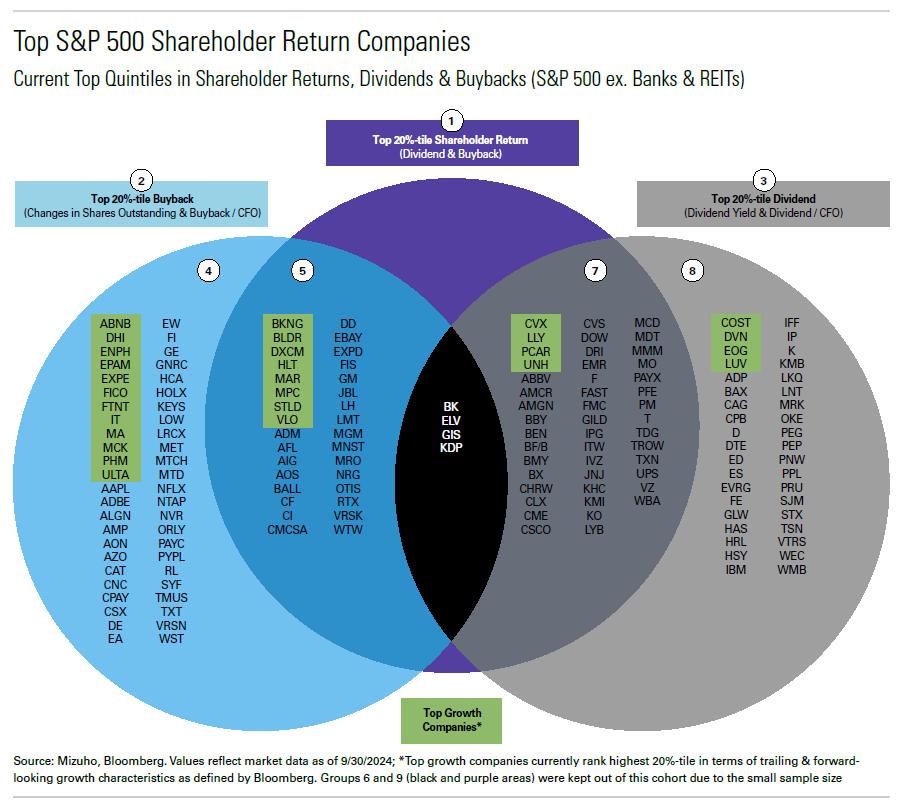Alphabet announced a dividend and reopened the debate on how to return capital to shareholders
November 2024
The question of how to reward and attract investors reared its head in April when tech giant Google’s parent company Alphabet announced it would pay a dividend to shareholders for the first time ever.
The move by Alphabet left more than a few investors wondering if it signaled a transition by the company from “startup” to a mature, large-cap stock that balances value and growth. Could it have indicated that the company’s growth had plateaued? Or that a broader tech sector transition from stock buyback to the humble dividend was underway?
Mizuho used this event as a springboard to look at the evolving landscape of maximizing shareholder return. We parsed through S&P 500 constituents from 201 to present and built three different investment portfolios: (1) top 20% of companies with the strongest buyback programs, (2) top 20% of companies with the best dividend policies and (3) the top 20% of companies with a strong combination of buybacks and dividends in aggregate. Each portfolio is equal-weighted, sector agnostic and rebalanced on a quarterly basis to reflect the latest rankings in each of the categories.
From there, we compared the performance of each strategy against one another as well as the broader equity market. Within the portfolio of companies we examined, those that are regularly in the top quintile of returning capital to shareholders in the form of buybacks performed better than the broader S&P 500.
More specifically, our findings showed that, in terms of returns, even though investors prefer a stronger emphasis on share buybacks versus dividends, a balanced approach is also rewarded. The Venn diagram below shows firms that are in the top quintiles in buybacks, dividends, and overall shareholder returns as of the end of the third quarter 2024.

In the analysis, we further examined those stocks that were deemed high growth and found that a growth company isn’t the only game in town. In fact, our results were not being driven by the outsized composition of these companies, and the only “Magnificent 7” tech firm in the buyback cohort is Apple. To be sure, companies who are “frequent” acquirers and have remained deft while doing so are stronger performers, according to a Bain & Co. study. These companies have won investor confidence through skillful execution of a disciplined capital allocation strategy.
On the other side, while investors trust their capital to well-performing firms, they will also pull their money when they question management’s investment logic. In February, social media giant Meta announced it would pay a dividend for the first time to shareholders and expand its share repurchasing plan. At the time, the news prompted a share price increase of more than 14% in extended trading.
Investors gave Meta less than a single quarter to prove some movement on these plans. By the end of April, the stock essentially sold off the equivalent of the February share increase, sinking 13% on news that its growth plan included a large capital commitment to unproven Artificial Intelligence initiatives. Investors showed their skepticism that Meta could undertake a steep investment in AI without a roadmap for quantifiable returns and took their money back1.
The Bottom Line
While tried and true, and certainly a staple for some investors, dividend programs are less flexible to management teams because once turned on, they can’t easily be turned off without risking the perception that a company is in crisis. Buybacks, on the other hand, can be utilized in a discretionary manner. Further, investors have flexibility in choosing when to monetize their positions as opposed to receiving cash and being forced to reinvest2. It’s no surprise then that this group of companies perform better. The bar chart below corresponds to the performance of each category described in the Venn diagram above and shows that in this group, companies that engaged in buybacks were the strongest performers during this period.

In sum, companies can demonstrate financial discipline to the market by providing steady shareholder returns. But there’s more to consider. Those that incorporate buybacks and dividends at a measured pace, in conjunction with reinvestment of capital into growth-oriented strategies, are further rewarded for their proficient and well-timed executive decision making.
Mizuho’s Strategic Solutions Group has many more insights to share on this and other topics. Please reach out to Sherif Lotfi or Nabil Ez-zaoui for more information.
1Meta is since trading near record highs as investors apprehension on the Metaverse has subsided2In addition, selling shares generates lower taxes as only the gain on the sale is taxed vs the entire dividend
For a PDF version of this article, please click here.

